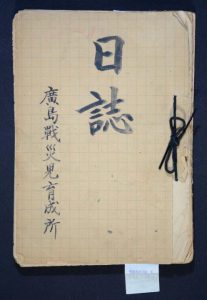Documenting Hiroshima of 1945: December 23, foster home for war orphans established with private funds
Dec. 23, 2024
Based on the creed “Be a father; be a mother”
by Minami Yamashita, Staff Writer
On December 23, 1945, the Hiroshima War Orphans Foster Home was established in the area of Itsukaichi-cho (in Hiroshima’s present-day Saeki Ward) in Hiroshima Prefecture. Based on his belief that children who had lost their parents in the atomic bombing “should not be left behind,” Gishin Yamashita, a Buddhist practitioner who died in 1989 at the age of 95, leased the land and buildings of the former prefectural agriculture research station, the site at which he built the foster home with his own funds.
According to a care log that recorded daily life at the foster home, seven war orphans arrived at the home around 7 p.m. on December 23. They were children from such schools as Ote-machi National School—which was closed down—who had been left behind at a mass evacuation site in the northern part of the prefecture. As a late-night snack, the staff gave the children candy and mandarin oranges.
Enjoyed walking on beach
The care log notes that Mr. Yamashita had addressed the staff after the children had gone to bed and indicated that “the staff were inspired by the magnitude of their responsibilities. All went to bed after 10 p.m., with hopes for the happiness of the children admitted to the home.” On December 24, after physical measurements were taken, the children took a walk on Inokuchi Beach. The log explains that the “children were so happy to see the sea after such a long time.” They climbed a mountain behind the beach to watch the sunrise and enjoyed playing dodgeball.
On December 28, 12 evacuees arrived from Nakajima National School (present-day Nakajima Elementary School, located in Hiroshima’s Naka Ward) and other schools that had been located near the hypocenter. The care log notes that, “All of the children had head lice … We smoked all their blankets with sulfur.” In Ikusei no Jakkan no Kiroku (in English, ‘Small record of care’), a publication consisting of 35 total chapters on the foster home’s history compiled by Mr. Yamashita, he recalled in Chapter 29 that, “Until DDT (insecticide) arrived, we continued making challenging and troublesome efforts to eradicate lice.”
Lost his second son
Mr. Yamashita had been demobilized from the military in September 1945. He heard about the plight of the home for orphans that had opened in the Hijiyama National School (present-day Hijiyama Elementary School, in Hiroshima’s Minami Ward) from an old friend who was serving as head of the Hiroshima City government’s Health Division. Chapter 1 of the history of the foster home reads, “A feeling of indignation suddenly began to burn in my heart. I felt as though something in my heart was crying out to me that ‘the orphans should not be left behind.’” Mr. Yamashita lost his second son, who had been mobilized as a student for the war effort, in the atomic bombing. He negotiated firmly with Hiroshima Prefectural Governor Tsunei Kusunose when he made the request to lease the site of the prefectural agriculture research station.
The foster home held its opening ceremony on January 19, 1946. Until March 1948, the home housed a branch school of Noboricho National School (present-day Noboricho Elementary School, in Hiroshima’s Naka Ward). Based on the creed “Be a father; be a mother,” the staff and children lived together, with each staff member assigned to around 10 children. The children would call Mr. and Mrs. Yamashita “grandpa” and “grandma.” A total of 171 children had lived in the foster home until 1953, when its management was transferred to the city government.
(Originally published on December 23, 2024)








